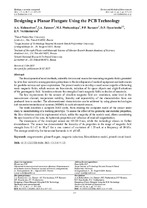Designing a Planar Fluxgate Using the PCB Technology

Authors
Date
2021Publisher
Another Title
Проектирование планарного феррозондового датчика по технологии печатных плат
Bibliographic entry
Designing a Planar Fluxgate Using the PCB Technology = Проектирование планарного феррозондового датчика по технологии печатных плат / A. A. Kolomeitsev [et al.] // Приборы и методы измерений. – 2021. – Т. 12, № 2. – С. 117-123.
Abstract
The development of novel methods, scientific devices and means for measuring magnetic fields generated by ultra-low current is among promising directions in the development of medical equipment and instruments for geodetic surveys and space exploration. The present work is to develop a small sensor capable of detecting weak magnetic fields, which sources are biocurrents, radiation of far space objects and slight fluctuations of the geomagnetic field. Scientists estimate the strength of such magnetic fields as deciles of nanotesla. The key requirements for the sensors of ultra-low magnetic field are: resolution, noise level in the measurement channel, temperature stability, linearity and repeatability of the characteristics from one produced item to another. The aforementioned characteristics can be achieved by using planar technologies and microelectromechanical systems (MEMS) in such advanced sensors. The work describes a complete R&D cycle, from creating the computer model of the sensor under study to manufacturing of a working prototype. To assess the effect of the geometry and material properties, the Jiles–Atherton model is implemented which, unlike the majority of the models used, allows considering the non-linearity of the core, its hysteresis properties and influence of residual magnetization. The dimensions of the developed sensor are 40×20×5 mm, while the technology allows its further diminishment. The sensor has demonstrated the linearity of its properties in the range of magnetic field strength from 0.1 nT to 50 μT for a rms current of excitation of 1.25 mA at a frequency of 30 kHz. The average sensitivity for the second harmonic is 54 μV/nT.
Abstract in another language
Разработка новых методов, научных приборов и средств для измерения магнитных полей, создаваемых сверхслабыми токами, является одним из перспективных направлений в развитии медицинской техники, геодезических и космических исследований. Целью данной работы являлась разработка малогабаритного датчика, способного детектировать слабые магнитные поля, источниками которых могут быть биотоки, излучения далёких космических объектов и слабые флуктуации магнитного поля земли. Учёные оценивают величины таких магнитных полей в десятые доли нанотесла. Среди ключевых требований к датчикам сверхслабого магнитного поля можно отнести разрешающую способность, уровень шумов в измерительном канале, температурную стабильность, линейность и повторяемость характеристик от изделия к изделию. Предлагается добиться этих характеристик путём применения планарных технологий и микроэлектромеханических систем при изготовлении современных датчиков. В работе описан полный цикл исследования, от создания компьютерной модели исследуемого датчика до изготовления рабочего прототипа. Для оценки влияния геометрических параметров и влияния свойств материала использована модель Джилса‒Атертона, которая, в отличие от большинства используемых моделей, позволяет учесть нелинейность сердечника, его гистерезисные свойства и влияние остаточной намагниченности. Габариты разработанного датчика составляют 40×20×5 мм и технически возможно его уменьшение. Разработанный датчик продемонстрировал линейность характеристик в диапазоне от 0,1 нТл до 50 мкТл при среднеквадратическом токе возбуждения 1,25 мА на частоте 30 кГц. Усреднённый коэффициент преобразования по второй гармонике составляет 54 мкВ/нТл.
View/
Collections
- Т. 12, № 2[9]
